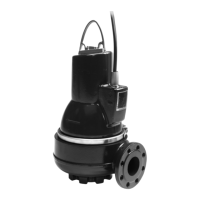English (GB)
10
6. Safety
For safety reasons, all work in tanks must be
supervised by a person outside the pump tank.
Tanks for submersible sewage and wastewater
pumps may contain sewage or wastewater with toxic
and/or disease-causing substances. Therefore, all
persons involved must wear appropriate personal
protective equipment and clothing, and all work on
and near the pump must be carried out under strict
observance of the hygiene regulations in force.
6.1 Potentially explosive environments
Use explosion-proof pumps for applications in
potentially explosive environments. See section
5.2 Explanation to Ex approval.
SL1 and SLV pumps are designed for two installation
types:
• submerged installation on auto coupling
• free-standing submerged installation on ring
stand.
Pump installation in tanks must be carried
out by specially trained persons.
Work in or near tanks must be carried out
according to local regulations.
Persons must not work in the installation
area when the atmosphere is explosive.
DANGER
Electric shock
Death or serious personal injury
- Before beginning the installation, switch
off the power supply and lock the main
switch in position 0 with a padlock to
ensure that the power supply cannot be
accidentally switched on. Any external
voltage connected to the pump must be
switched off before working on the
pump."
We recommend that you make all
maintenance and service work when the
pump is placed outside the tank.
WARNING
Crushing hazard
Death or serious personal injury
- Make sure that the lifting bracket is
tightened before attempting to lift the
pump. Tighten if necessary.
Carelessness during lifting or
transportation may cause injury to
personnel or damage to the pump.
SL1 and SLV pumps must under no
circumstances be used to pump explosive,
flammable or combustible liquids.
The classification of the installation site
must be approved by the local fire-fighting
authorities in each individual case.
Special conditions for safe use of SL1 and
SLV explosion-proof pumps:
1. Make sure the moisture switch and
thermal switches are connected in the
same circuit but have separate alarm
outputs (motor stop) in case of high
humidity or high temperature in the
motor.
2. Bolts used for replacement must be
class A2-70 or better according to EN/
ISO 3506-1.
3. Contact the manufacturer for
information on the dimensions of the
flameproof joints.
4. The level of pumped liquid must be
controlled by two level switches
connected to the motor control circuit.
The minimum level depends on the
installation type and is specified in
these installation and operating
instructions.
5. Make sure the permanently attached
cable is suitably mechanically
protected and terminated in a suitable
terminal board placed outside the
potentially explosive area.
6. The sewage pumps have an ambient
temperature range of -20 °C to +40 °C
and a maximum process temperature
of +40 °C. The minimum ambient
temperature for a pump with a water-
in-oil sensor is 0 °C.
7. The thermal protection in the stator
windings has a nominal switch
temperature of 150 °C and must
guarantee the disconnection of the
power supply. The power supply must
be reset manually.
8. The control unit must protect the WIO
sensor against short circuit current of
the supply to which it is connected. The
maximum current from the control unit
must be limited to 350 mA.
9. In case of frequency converter usage,
the maximum surface temperature of
the pump can be 200 °C.
10. The WIO sensor is intended for use
only with a galvanically isolated circuit.
11. The lock nut of the cable connector
must only be replaced with an identical
one.
EX pumps are equipped with a WIO
sensor optionally.

